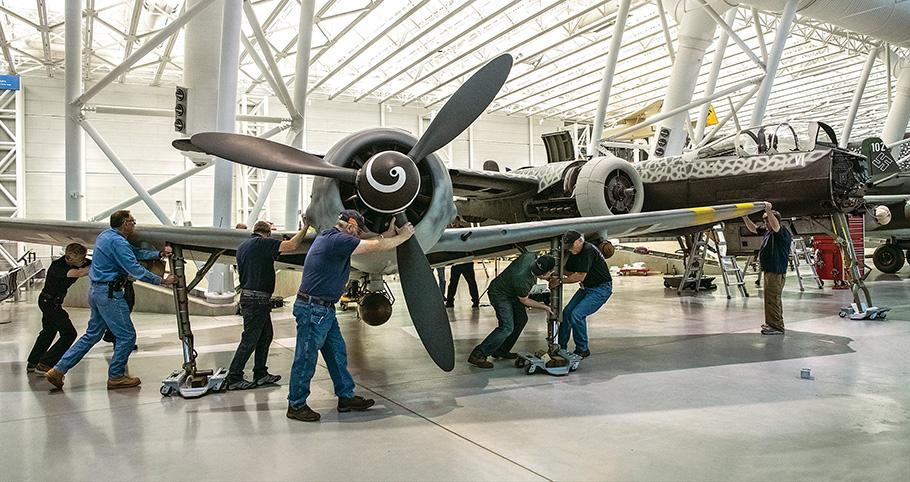
Dream Work
Mar 22, 2022
By Diane Tedeschi
Restoring old airplanes is the only thing Chris Reddersen has ever wanted to do.
Chris Reddersen is a restoration specialist at the National Air and Space Museum’s Steven F. Udvar-Hazy Center in Chantilly, Virginia. After serving as a Museum volunteer for two years, Reddersen became a full-time salaried employee in 2016. He is the preservation-and-restoration-unit lead assigned to Flak-Bait, a Martin B-26B-25-MA that served with the U.S. Army Air Forces in World War II. Reddersen recently discussed his work for the Museum with Air & Space Quarterly senior editor Diane Tedeschi.
How did you get your job?
Around the age of eight, I went to one of the open houses that the shop used to hold at the Paul E. Garber Preservation, Restoration, and Storage Facility in Suitland, Maryland. And there I saw museum specialists working on restoring the Japanese Seiran floatplane. It was a lightbulb moment for me—like, I want to do that. But as an eight-year-old kid, I had no idea how to go about doing that. Going through elementary, middle, and high school, I figured aerospace engineering is about aircraft, right? So maybe that’s how you do that.
I got accepted at Virginia Tech and received my bachelor’s degree in aerospace engineering. But the first job I got hired to do was HVAC [heating, ventilation, and air conditioning]. And I thought, “Okay. Well, this is just the way things are. I’ll never get to actually work at Air and Space.” But a few years later, I ended up going to one of the local chapter meetings for the Experimental Aircraft Association, and at the end of the meeting they said, “Do we have any new members?” I stood up and introduced myself: “Hi, my name’s Chris Reddersen, and all I’ve ever wanted to do is work on historic aircraft.” It just so happens that one of the people who was at the meeting was [veteran Museum restoration specialist] Anne McCombs. She snapped her head around and said, “Talk to me after the meeting.” So I met up with her after the meeting, and she got the ball rolling by initiating the paperwork to get me hired as a volunteer at the Air and Space Museum.
The late Rob Mawhinney (at left) and Reddersen (holding a nose-gear actuator from the Heinkel He 219) consult a Luftwaffe maintenance manual for the 219. Mawhinney was an experienced aircraft restoration specialist. During his 22 years at the National Air and Space Museum, he oversaw numerous projects. He died last November.
What is the difference between restoration and conservation?
With restoration, you are taking something and trying to return it to a certain point in its lifespan. If you look at the Enola Gay, for example, it’s really only famous because of one event in its life. So when the work was being done on Enola Gay, the idea was to return it back to that day [August 6, 1945]. Conservation on the other hand is taking an aircraft or an artifact and trying to keep it from degrading any further. You’re trying to halt the aging process. In some cases, there’s a blurring of the lines between the two, and because of that—for every single artifact, aircraft, whatever—there’s usually a big discussion about where that line is.
One of the things we talk about when we approach a project is how intrusive we are going to be with the care that we give to an artifact. In some cases, we try to be as light-handed as possible—maybe you just need to put a coat of wax over something. But if there’s a structural issue that is risking the artifact, then your hand is forced. Because if the structure fails, then the artifact fails, and that’s not something anybody wants.
What are some of the restoration projects you have worked on?
I’ve worked on the Apollo Telescope Mount—as an assistant. More recently, I’ve done treatments on Tingmissartoq [a Lockheed Sirius flown by Charles and Anne Morrow Lindbergh], the Northrop Alpha, and the Curtiss Headless Pusher. And I’ve assisted with the Heinkel 219, which is a night fighter manufactured late in World War II for Germany’s Luftwaffe pilots.
Reddersen’s coworker, Jay Flanagan, works on the wing of a Lincoln-Standard biplane. He is sanding a replacement part made of aircraft-grade spruce.
And you have also worked on the Lincoln-Standard biplane, correct?
Yeah, I have done some work on that one. Although I’m the first to point out that a lot of the work you see was actually done by my amazing coworker, Jay Flanagan.
The Heinkel 219 was manufactured in Nazi Germany, and lo and behold here it is in an American restoration facility. What did you think when you saw this rare aircraft sitting there on the shop floor?
As someone who’s gone through an engineering degree program, I think it’s a remarkable piece of engineering. One of the catchphrases of the late Rob Mawhinney*—who was acting as the 219’s project lead—used to be, whenever we’d find something really odd or goofy, he’d just say, “Oh, those wacky [engineers].” There’s an element of truth to that because the 219 seems put together in a way that is unnecessarily complicated. In many instances, there is probably a perfectly good explanation for why something is done that way, but case in point is the 219’s nose gear. When we were first assembling everything on the floor, we put the nose-gear actuator in, and there’s a bolt that holds it on. Then there’s a bolt that holds that bolt, and then there’s a cotter pin that holds the bolt that holds the bolt. It all spirals after a while.
What did you learn from Rob Mawhinney?
Patience is something I learned from Rob. Just because you’re not seeing an answer now doesn’t mean it’s not there. One of the things I really miss about having him around to consult is that a lot of times if you had a problem—like you’re trying to rig an aircraft and you’re just not seeing how to do it—you’ll go up to him and ask, “Hey, can you take a look at this?” And he’ll walk out to the airplane in the shop, look at it for 30 seconds, and he’s already got an idea of what to do. And then almost in a school-teacherly manner, he would guide you to the realization of where you should be. Whatever the crux of your problem was, he would lead you to it.
Getting the Heinkel 219’s fuselage (at right) into it’s designated spot in the Museum’s Boeing Aviation Hangar required the restoration team to first move the nearby Focke-Wulf Fw 190 and then wrangle it back into position.
After you started working full-time, how long did it take before you could say, “I’ve got this. I know what I’m doing here”?
That’s a tough question to answer because every project assigned to us is a one-off. The way I’ve described the shop is that we’re almost a bespoke restoration operation. Generally speaking, there is nothing we do that’s the same twice. Even now, I both feel like I understand what I’m doing, but at the same time don’t. Coming into work every day, I never feel like I’m out of my depths or the water is above my head, but every project presents different challenges and different questions that need answers. I accept that with every project, there will probably be something that throws me for a loop. For example, if I’m trying to figure out how to rig an aircraft for display in a gallery—and no one else in the world has ever tried to rig this particular aircraft type—I know it’s going to be an interesting puzzle. How am I going to figure this out?
Historic aircraft receive the utmost care from the Museum’s dedicated team of restoration experts. Reddersen (center) and the crew gently lower the 219’s restored nose landing gear into place.
What is the best thing about your job?
Oh, just about everything. Like you were saying, getting to walk in here and seeing these aircraft that are the last of their kind—how can you really beat that? And sometimes there’s an opportunity to talk to the veterans who once flew these historic aircraft. Several years ago, a group of B-26 crew members came through the shop to see Flak-Bait. I got to talk with a couple of the guys and hear their stories while Flak-Bait was parked just behind me, listening in—that was a pretty cool feeling. It’s one of the reasons why I adore every part of this job. Yes, the machines are incredible, but the men and women who operated them even more so.
Related Topics
You may also like
We rely on the generous support of donors, sponsors, members, and other benefactors to share the history and impact of aviation and spaceflight, educate the public, and inspire future generations. With your help, we can continue to preserve and safeguard the world’s most comprehensive collection of artifacts representing the great achievements of flight and space exploration.




